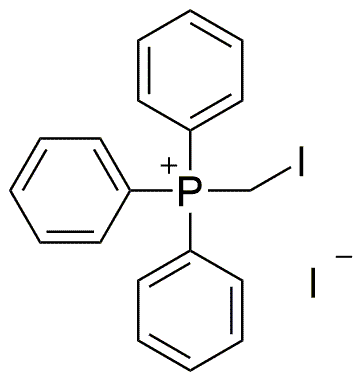(Iodomethyl)triphenylphosphonium iodide is widely utilized in research focused on:
- Synthetic Chemistry: This compound serves as a versatile reagent for the synthesis of various organic compounds, particularly in the formation of carbon-carbon bonds, enhancing the efficiency of chemical reactions.
- Pharmaceutical Development: It is employed in the development of new drugs, especially in the creation of phosphonium-based compounds that exhibit biological activity, aiding researchers in discovering novel therapeutic agents.
- Material Science: The compound is used in the fabrication of advanced materials, including polymers and nanomaterials, where its unique properties contribute to improved performance and stability.
- Bioconjugation: It plays a role in bioconjugation techniques, allowing for the attachment of biomolecules to surfaces or other molecules, which is crucial in the development of biosensors and targeted drug delivery systems.
- Organic Photovoltaics: This chemical is involved in the development of organic solar cells, where it helps improve the efficiency of energy conversion, making renewable energy technologies more viable.
General Information
Properties
Safety and Regulations
Applications
(Iodomethyl)triphenylphosphonium iodide is widely utilized in research focused on:
- Synthetic Chemistry: This compound serves as a versatile reagent for the synthesis of various organic compounds, particularly in the formation of carbon-carbon bonds, enhancing the efficiency of chemical reactions.
- Pharmaceutical Development: It is employed in the development of new drugs, especially in the creation of phosphonium-based compounds that exhibit biological activity, aiding researchers in discovering novel therapeutic agents.
- Material Science: The compound is used in the fabrication of advanced materials, including polymers and nanomaterials, where its unique properties contribute to improved performance and stability.
- Bioconjugation: It plays a role in bioconjugation techniques, allowing for the attachment of biomolecules to surfaces or other molecules, which is crucial in the development of biosensors and targeted drug delivery systems.
- Organic Photovoltaics: This chemical is involved in the development of organic solar cells, where it helps improve the efficiency of energy conversion, making renewable energy technologies more viable.
Documents
Safety Data Sheets (SDS)
The SDS provides comprehensive safety information on handling, storage, and disposal of the product.
Product Specification (PS)
The PS provides a comprehensive breakdown of the product’s properties, including chemical composition, physical state, purity, and storage requirements. It also details acceptable quality ranges and the product's intended applications.
Certificates of Analysis (COA)
Search for Certificates of Analysis (COA) by entering the products Lot Number. Lot and Batch Numbers can be found on a product’s label following the words ‘Lot’ or ‘Batch’.
Numéro de catalogue
Numéro de lot/série
Certificates Of Origin (COO)
This COO confirms the country where the product was manufactured, and also details the materials and components used in it and whether it is derived from natural, synthetic, or other specific sources. This certificate may be required for customs, trade, and regulatory compliance.
Numéro de catalogue
Numéro de lot/série
Safety Data Sheets (SDS)
The SDS provides comprehensive safety information on handling, storage, and disposal of the product.
DownloadProduct Specification (PS)
The PS provides a comprehensive breakdown of the product’s properties, including chemical composition, physical state, purity, and storage requirements. It also details acceptable quality ranges and the product's intended applications.
DownloadCertificates of Analysis (COA)
Search for Certificates of Analysis (COA) by entering the products Lot Number. Lot and Batch Numbers can be found on a product’s label following the words ‘Lot’ or ‘Batch’.
Numéro de catalogue
Numéro de lot/série
Certificates Of Origin (COO)
This COO confirms the country where the product was manufactured, and also details the materials and components used in it and whether it is derived from natural, synthetic, or other specific sources. This certificate may be required for customs, trade, and regulatory compliance.


